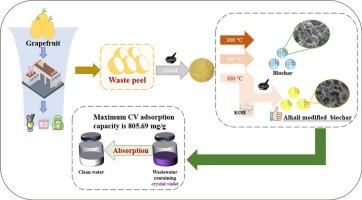利用碱改性柚子皮生物炭吸附废水中的结晶紫
IF 6.3
2区 工程技术
Q1 ENGINEERING, CHEMICAL
引用次数: 0
摘要
本研究旨在探讨碱改性柚子皮生物炭的最佳制备条件,并阐明其对结晶紫(CV)的吸附过程。研究对不同表皮层的柚子皮原料的热解温度和碱碳比进行了评估和优化。多项表征技术表明,碱性改性可通过改变生物炭的孔隙结构和官能团组成来提高其吸附性能。值得注意的是,来自柚子外表皮的生物炭在 900 °C(KC2)温度下经过 2:1 的碱碳比改性后,通过孔隙填充、氢键、π-π 相互作用、静电作用以及包括 CC 和 COC 在内的官能团等机制,表现出显著的吸附能力。Freundlich 等温线和伪二阶动力学模型被确定为最适合描述平衡数据的模型。因此,KC2 的最大吸附容量为 805.69 mg/g,大大超过了在 900 °C 高温下热解柚子皮(BC-GOP900,586.7 mg/g)所产生的生物炭。这项研究最终得出结论,利用柚子皮生物炭,特别是 KC2,是解决 CV 污染的一种创新战略,同时还能有效地重新利用农业废弃物。本文章由计算机程序翻译,如有差异,请以英文原文为准。

Adsorption of crystal violet from wastewater using alkaline-modified pomelo peel-derived biochar
The purpose of this study is to investigate the optimal preparation conditions for alkali-modified pomelo peel biochar and to clarify its adsorption process towards crystal violet (CV). The pyrolysis temperature and the alkali-to-carbon ratio of pomelo peel raw materials with varying epidermal layers were evaluated and optimized. Several characterization techniques demonstrated that alkaline modification enhances the adsorption performance of biochar by modifying its pore structure and functional group composition. Notably, the biochar, derived from the outer epidermis of pomelo, modified with an alkali-to-carbon ratio of 2:1 at 900 °C (KC2), exhibited significant adsorption capacity through mechanisms such as pore filling, hydrogen bonding, π-π interactions, electrostatic interactions, and functional groups including C![]() C and C
C and C![]() O
O![]() C. The Freundlich isotherm and the pseudo-second-order kinetic model were determined to be the most appropriate for describing the equilibrium data. Accordingly, KC2 exhibited a maximum adsorption capacity of 805.69 mg/g, which significantly exceeded that of biochar derived from pomelo peel with a basic outer epidermis pyrolyzed at 900 °C (BC-GOP900, 586.7 mg/g). This study ultimately concluded that utilizing pomelo peel biochar, particularly KC2, represents an innovative strategy to address pollution caused by CV while effectively repurposing agricultural waste.
C. The Freundlich isotherm and the pseudo-second-order kinetic model were determined to be the most appropriate for describing the equilibrium data. Accordingly, KC2 exhibited a maximum adsorption capacity of 805.69 mg/g, which significantly exceeded that of biochar derived from pomelo peel with a basic outer epidermis pyrolyzed at 900 °C (BC-GOP900, 586.7 mg/g). This study ultimately concluded that utilizing pomelo peel biochar, particularly KC2, represents an innovative strategy to address pollution caused by CV while effectively repurposing agricultural waste.
求助全文
通过发布文献求助,成功后即可免费获取论文全文。
去求助
来源期刊

Journal of water process engineering
Biochemistry, Genetics and Molecular Biology-Biotechnology
CiteScore
10.70
自引率
8.60%
发文量
846
审稿时长
24 days
期刊介绍:
The Journal of Water Process Engineering aims to publish refereed, high-quality research papers with significant novelty and impact in all areas of the engineering of water and wastewater processing . Papers on advanced and novel treatment processes and technologies are particularly welcome. The Journal considers papers in areas such as nanotechnology and biotechnology applications in water, novel oxidation and separation processes, membrane processes (except those for desalination) , catalytic processes for the removal of water contaminants, sustainable processes, water reuse and recycling, water use and wastewater minimization, integrated/hybrid technology, process modeling of water treatment and novel treatment processes. Submissions on the subject of adsorbents, including standard measurements of adsorption kinetics and equilibrium will only be considered if there is a genuine case for novelty and contribution, for example highly novel, sustainable adsorbents and their use: papers on activated carbon-type materials derived from natural matter, or surfactant-modified clays and related minerals, would not fulfil this criterion. The Journal particularly welcomes contributions involving environmentally, economically and socially sustainable technology for water treatment, including those which are energy-efficient, with minimal or no chemical consumption, and capable of water recycling and reuse that minimizes the direct disposal of wastewater to the aquatic environment. Papers that describe novel ideas for solving issues related to water quality and availability are also welcome, as are those that show the transfer of techniques from other disciplines. The Journal will consider papers dealing with processes for various water matrices including drinking water (except desalination), domestic, urban and industrial wastewaters, in addition to their residues. It is expected that the journal will be of particular relevance to chemical and process engineers working in the field. The Journal welcomes Full Text papers, Short Communications, State-of-the-Art Reviews and Letters to Editors and Case Studies
 求助内容:
求助内容: 应助结果提醒方式:
应助结果提醒方式:


